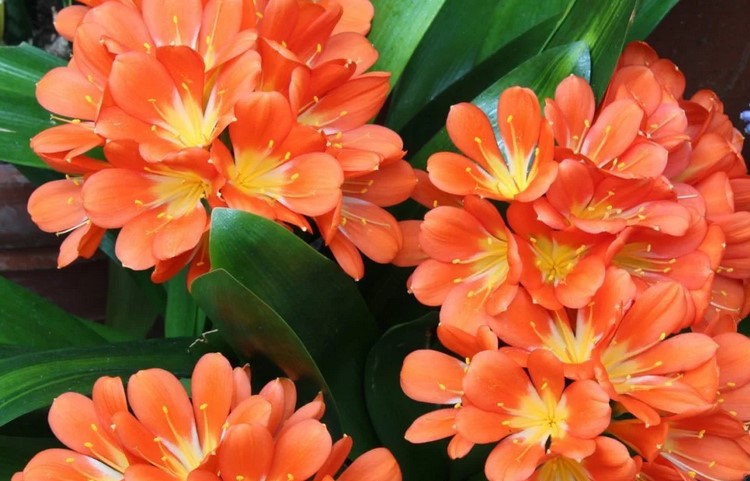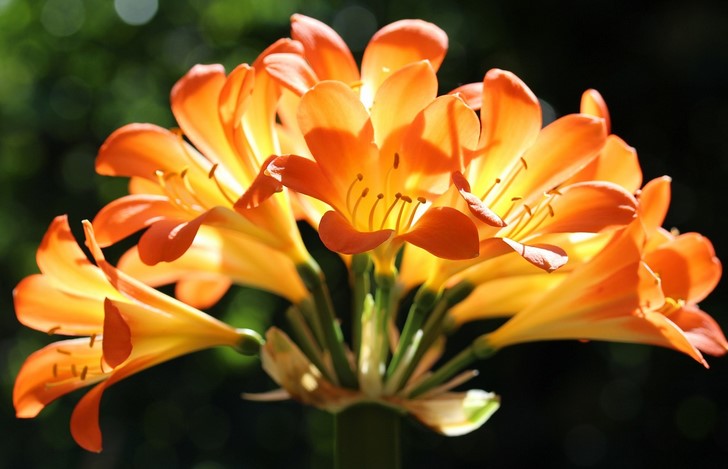Clivia, the bush lily, is a flowering plant native to southern Africa. It belongs to the Amaryllidaceae family. Among other names, Clivia is commonly known as the Natal lily. If you’re looking for a plant with unique flowers, this plant might be a good choice for you.
The Natal lily (Clivia miniata) is the species that founded this family of flowering plants (Amaryllidaceae.) Native to South Africa, the Natal lily grows naturally into large clumps in woodland habitats. It is also found in Southern Mozambique and areas of Swaziland, although only in these locations as a garden escapee. Although often mistaken for a bulb, it is actually a geophyte, not requiring dormant periods like true bulbs.
Clivia miniata
Clivia miniata, or the Natal lily, is a native plant of southern Africa. It is a member of the Clivia genus in the Amaryllidaceae family and grows in woodland habitats in South Africa and Eswatini. Clivia plants grow in large clumps and are water-wise.
Clivia can tolerate low light, but it is best to keep its soil moist without overwatering it. The soil should not become soggy for prolonged periods of time, or it may suffer from rot. Overwatering also leads to yellowed leaves and stunted growth.
Overwatering is the most common cause of death in Clivia plants, so take steps to prevent it from succumbing to the same fate.
Clivia miniata plants require ample watering during the active growth period, and need less water during the resting period. However, they should not be overwatered, as it can result in root rot, and even death of the plant. In addition to watering, Clivia miniata needs a good liquid fertilizer once a month, after the flower stalks have developed half way. This fertilization should be continued for a month before cutting down on watering.

Clivia nobilis
Clivia nobilis has beautiful red berries that can be harvested. Once the berries turn red, remove them and cover them with a thin layer of soil. The seeds will germinate within 6-8 weeks and it may take up to six years for the seedlings to flower. Unlike Clivia miniata, which requires a large amount of water to survive, Clivia nobilis can tolerate little water and will grow in most soils. The flowers are pinkish with green tips.
Clivia nobilis is one of the earliest Clivia species and is considered the type species for the genus. It requires little water and grows slowly compared to other species. This makes it a low-maintenance plant. The primary threats to the plant include snout beetles, which can damage the leaves but are easily controlled by a contact insecticide. Rot can also threaten the seeds, and should be treated as soon as they start to sprout.
Clivia nobilis prefers shady areas. It is usually found in gardens and forested areas, where it grows well. It does best in partial or full shade, but can tolerate dappled sunlight as well. It also thrives in the early morning shade under large trees. Regular watering is necessary during the summer, but avoid over- watering.
Clivia nobilis var. citrina
Clivia nobilis is a perennial that is found in a wide range of colors and flower forms. It has pendant tube-shaped flowers with green edging. It was first discovered in the
Limpopo Province in the 1890s and described in 1943. This is the only species of Clivia that has real stems. It grows up to six feet tall, is hardy, and is tolerant of hot summers and cool winters. It also tolerates occasional light frost at higher elevations.
Clivia nobilis is a slow grower. It takes about 6 years to grow from seed and bloom. It produces bright orange flowers with a green tip. This plant grows best in partial shade. Regular watering is needed to keep it healthy and happy. The plant’s blooms appear in late autumn to winter. The flowers are long and pendulous and are orange-red with green tips.
The soil mix for Clivia should contain a balance of K and N. The amount of N should be in a ratio of 1:2. Too much nitrogen can promote the growth of leaves instead of flowers. When fertilizing, use an organic or slow release fertilizer and apply it once a year. If you’re growing Clivia in containers, you should apply liquid fertilizer every month. It is important to remember that Clivia does not need as much fertilizer during the winter because it is in a resting period.

Clivia miniata var. citrina
The plant Clivia miniata var. citrina has buttery-yellow flowers that are supported by a peduncle that grows up to 50 cm tall. This plant is one of the parents of pure yellow hybrids. Despite this flower’s attractive appearance, it is highly poisonous.
This plant is an excellent choice for partial shade gardens. Its flowers are a pale lemon-yellow colour and have a green median strip down the length of the tepals. It also has six stamen and yellow pollen. The plant is slow-growing and does not need to be fertilised.
This plant grows to one to two feet tall. The leaves are strap- shaped and have rounded tips. The yellow flowers are long-lasting and appear at the end of the stalk. It prefers bright shade, moderate watering, and temperatures no more than freezing. The plant was named by John Lindley after Lady Clive, Duchess of Northumberland. It is native to the Eastern Transvaal region of South Africa, Swaziland, and Madagascar. Its seeds are available from Silverhill Seeds in South Africa.
The plant prefers a well-drained soil with a pH of 5.5-6.5. It also grows well in a greenhouse or in a shaded room. During the active growing season, water the plant when the top one to two inches of soil becomes dry. However, watering during the winter months should be limited to the first three to five inches of soil.
Given the right conditions, Clivia makes an excellent house plant, but with a few considerations to help it thrive. The most important is selecting a variety suited to low-light environments and then placing it in an appropriate location. One of the best things about this plant is that it needs very little attention beyond those initial steps, but will repay you with a bright display of beautiful flowers time and time again.

